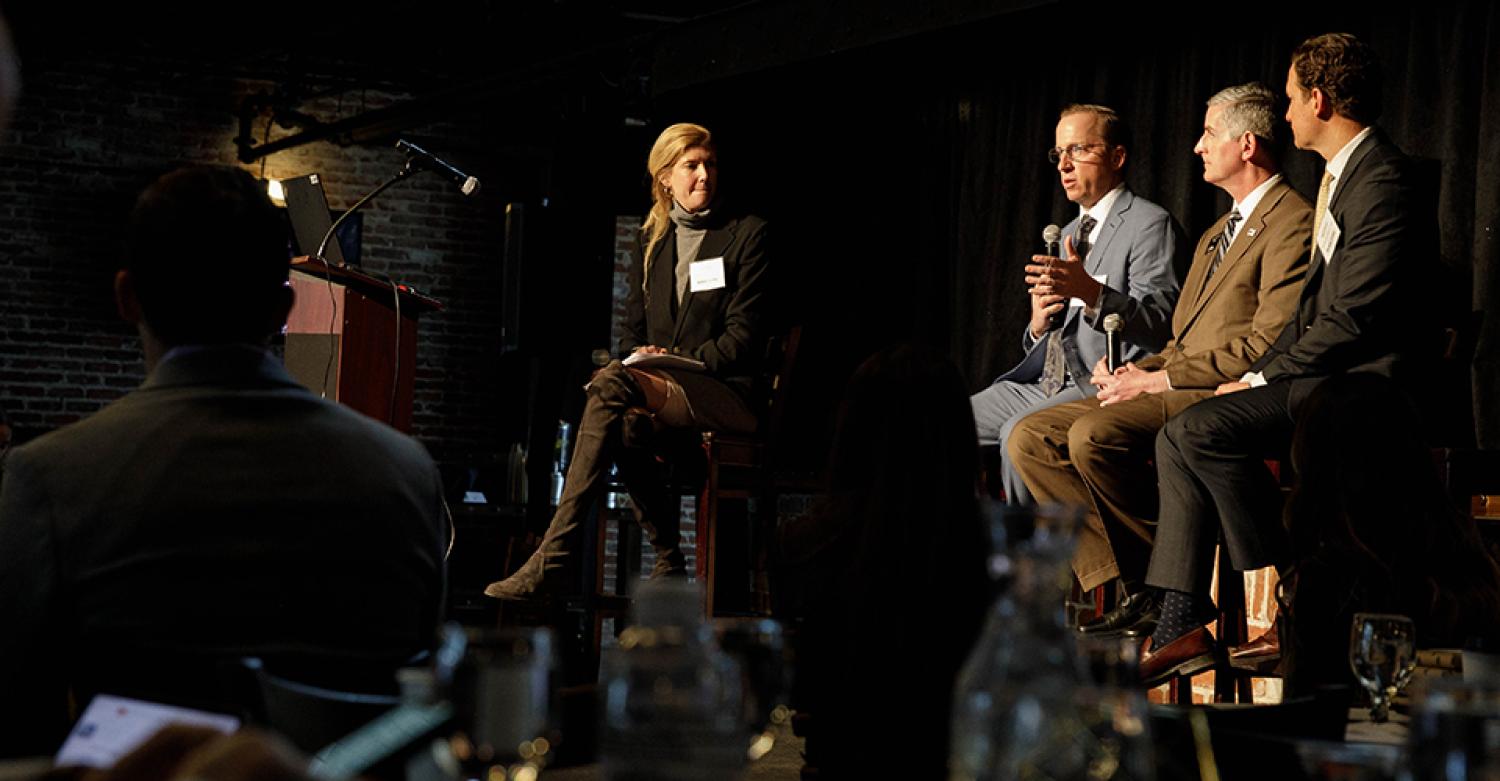Real Estate Forum Shows Optimism is Building, Even as Disasters Dominate Discussion

The Marshall Fire and pandemic were headliners, but panelists remained upbeat about the industry’s prospects in Denver and beyond.
Michael Conway, state insurance commissioner, answers an audience question as fellow panelists Clint Folsom and David Sinkey listen in. To their left is moderator Lily Colley Ferguson, of Everwest.
The Marshall Fire represented the largest loss of property from a single fire in Colorado history.
It’s a record that’s unlikely to stand long.
That was the sobering takeaway of a panel discussion on rebuilding after the fire during the CU Real Estate Center’s 25th annual forum on March 9 at Mile High Station, in Denver.
Panelist Michael Conway, insurance commissioner for the state of Colorado, grew up in California, and the Thomas Fire—which struck Ventura in 2017—was the biggest fire in the state’s history at the time.
“Now, it’s the seventh-biggest fire,” he said. “In five years, we’ve had six bigger fires. And the same thing is now happening in Colorado.”
Conway, along with his fellow panelists—Superior Mayor Clint Folsom and David Sinkey (Fin, Entrep’01), president and CEO of Boulder Creek Neighborhoods—shared their perspectives on what they learned from the fire and how to rebuild. Unsurprisingly, insurance—especially underinsurance—came up frequently.
The panelists pointed to climate change’s role in accelerating the risk and volatility in the insurance and building industries. Sinkey noted that you previously had to account for the risk of fire if you lived in a mountain community, “but now, it’s in the suburbs.”
'Extremely volatile' costs
There is great uncertainty in the rebuilding process. At Boulder Creek, Sinkey said, “the entire purchasing department can’t tell me what anything will cost. … Not only have the costs moved dramatically, they’re extremely volatile.” Supply chain issues, he said, are causing additional challenges in obtaining higher-quality building materials that better resist fire.
And while a developer like Boulder Creek can build large communities that help rein in costs, he said, rebuilding individual custom homes—especially at the speed fire victims need to move at—acts as a further cost driver.
Folsom has had a front-row seat to the challenges around insurance. A property owner, he rented to students in Boulder during the floods of a decade ago, and has fielded a lot of the same questions since the fire.
“This was an eye-opener—entire subdivisions were blown away,” he said. “Please, review your insurance policies. Have a conversation with your insurance agent.”
The fire wasn’t the only disaster that took center stage at the Forum. Sarah McGarry, principal and workplace sector lead at Stantec, walked the audience of more than 300 through her panic, in the early days of the pandemic, when the design and consulting company wondered if the office would be among the casualties of COVID-19.
The demise of the office, she said, has been greatly exaggerated, but the pandemic ushered in new design priorities—like collaborative capacity, wellness, and employee engagement. Her design work today involves conversations with individual employees using these spaces to better understand how they work and their needs.
“Real estate utilization will not be defined by the amount of square feet per person, but by how connected and engaged employees are,” McGarry said.
And while the idea of one size not fitting all companies was a theme she returned to regularly, McGarry said leaders need to be more prescriptive about their own hybrid working arrangements. Otherwise, the chief benefit of in-person work—collaboration—goes out the window.
“Real estate utilization will not be defined by the amount of square feet per person, but by how connected and engaged employees are.”
Sarah McGarry, principal and workplace sector lead, Stantec
“If you have a company of 20 employees, and they all say they’ll work from home one day a week … there is a less than 15% chance you’ll have half the staff there on a given day,” she said.
The Forum—which traces its roots to the launch of the real estate program at the University of Colorado Boulder—offered a broad perspective on a number of topics in real estate, including a close-up of four high-stakes projects in Denver, an examination of best practices in ESG and a one-on-one conversation with Phillip A. Washington, CEO of Denver International Airport—a $30 billion-plus economic engine for the region and the third-busiest airport in the world.
Washington, who served on Joe Biden’s presidential transition team, briefly celebrated the infrastructure bill that was signed late last year, which will direct $25 billion to airports. He expects Denver International Airport to get a large share, owing to its size and the potential for further development in the region, but also because of the emphasis he’s created around on diversity and equality—both features of his long career.
“The development of young people I see as part of my duties as a CEO,” he said. “I am a civil rights baby, my mother used to take me to civil rights things in the 1960s … and it stuck with me, the idea of equality, of diversity. Providing opportunities to people who otherwise would not have those opportunities is very important to me.”
The forum also included a networking session and career fair for students studying real estate at the Leeds School of Business; 25 companies that are actively hiring across commercial real estate attended.
In his opening remarks, Michael Kercheval, executive director of CUREC, discussed the role of industry in creating relevant academic programs for students, which has helped CUREC boast a near-100% placement rate for its graduates. Leeds offers an undergraduate emphasis in real estate, as well as an MBA pathway and master’s program in the discipline.







